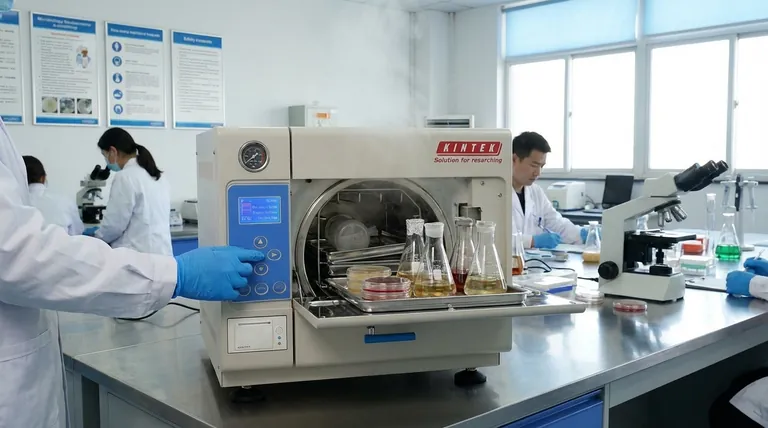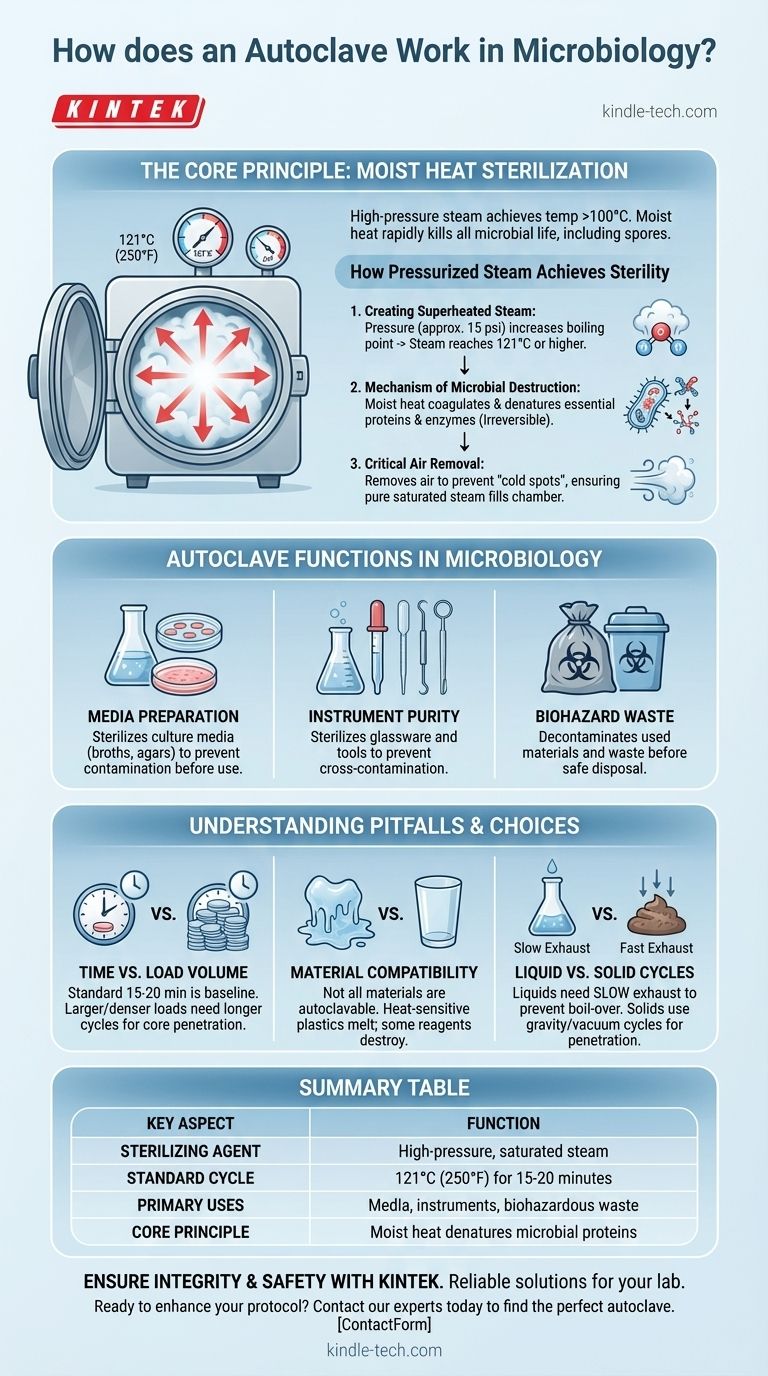An autoclave works by using high-pressure steam to achieve temperatures far beyond the boiling point of water. In a typical microbiology setting, this means reaching at least 121°C (250°F) for 15-20 minutes. This combination of intense heat and moisture rapidly and effectively kills all forms of microbial life, including bacteria, viruses, and highly resistant spores, ensuring that instruments, media, or waste are completely sterile.
The core principle is not just heat, but moist heat sterilization. By increasing pressure inside a sealed chamber, an autoclave creates saturated steam that efficiently transfers lethal heat to every surface, irreversibly damaging the essential proteins of microorganisms.

The Core Principle: How Pressurized Steam Achieves Sterility
An autoclave's effectiveness comes from a simple law of physics: the boiling point of water increases as pressure rises. It harnesses this principle to create an environment far more lethal to microbes than boiling water alone.
Creating Superheated Steam
Inside the sealed autoclave chamber, pressure is increased to approximately 15 pounds per square inch (psi) above atmospheric pressure.
This elevated pressure prevents water from boiling at 100°C, allowing the steam to reach a temperature of 121°C or higher. This superheated, saturated steam is the active sterilizing agent.
The Mechanism of Microbial Destruction
This high-temperature steam rapidly coagulates and denatures essential proteins and enzymes within microbial cells.
This process is irreversible and destroys the cell's ability to function or reproduce. Moist heat is significantly more effective and faster at this than dry heat because water helps break down protein structures.
The Critical Role of Air Removal
Before sterilization begins, nearly all air must be removed from the chamber. Trapped air creates "cold spots" that steam cannot penetrate.
This ensures that only pure, saturated steam fills the chamber, guaranteeing that all items reach the target sterilization temperature.
The Autoclave's Function in a Microbiology Lab
In microbiology, sterility is not optional; it is the foundation of reliable and safe work. The autoclave is the primary tool for achieving this.
Preparing a Sterile Foundation
The most common use is sterilizing culture media—the nutrient broths and agars used to grow microorganisms. Any existing contamination would ruin an experiment before it even starts.
Ensuring Instrument Purity
Glassware, pipette tips, metal loops, and other laboratory equipment must be sterilized before use. This prevents cross-contamination between different experiments or samples.
Decontaminating Biohazardous Waste
After an experiment, all used materials, such as petri dishes with bacterial colonies, are treated as biohazardous waste. Autoclaving is the gold-standard method for decontaminating this waste before it can be safely discarded.
Understanding the Trade-offs and Common Pitfalls
While highly effective, operating an autoclave requires understanding its limitations to ensure safety and success.
Time vs. Load Volume
The standard cycle of 121°C for 15-20 minutes is a baseline. Larger or denser loads, like a full basket of glassware or a large flask of media, require longer cycle times to ensure heat penetrates to the core of the load.
Material Compatibility
Not all materials can be autoclaved. Heat-sensitive plastics will melt, and certain reagents, such as some antibiotics or vitamins added to media, will be destroyed by the high temperatures.
Liquid vs. Solid Cycles
Autoclaves have different cycles for liquids and solids. Liquid cycles use a slower exhaust phase to cool down and depressurize. Venting too quickly will cause liquids to boil over violently, creating a mess and a safety hazard.
Making the Right Choice for Your Goal
Selecting the correct cycle is crucial for achieving effective sterilization without damaging your materials or creating a safety risk.
- If your primary focus is sterilizing liquid media: Always use a dedicated liquid cycle with a slow exhaust to prevent boil-over and ensure media volume is not lost.
- If your primary focus is decontaminating solid waste: Use a standard gravity or vacuum cycle designed for solids to ensure full steam penetration, and consider adding a dry cycle to reduce moisture before disposal.
- If your primary focus is sterilizing instruments: Ensure items are properly cleaned beforehand and wrapped in materials that allow steam to penetrate but maintain sterility after the cycle is complete.
Mastering the principles of autoclaving is fundamental to ensuring the safety, reliability, and integrity of your microbiological work.
Summary Table:
| Key Aspect | Function in Microbiology |
|---|---|
| Sterilizing Agent | High-pressure, saturated steam |
| Standard Cycle | 121°C (250°F) for 15-20 minutes |
| Primary Uses | Sterilizing culture media, lab instruments, and biohazardous waste |
| Core Principle | Moist heat denatures microbial proteins, ensuring sterility |
Ensure the integrity and safety of your lab work with reliable sterilization solutions from KINTEK.
Autoclaves are the cornerstone of a safe and contamination-free microbiology lab. Whether you are sterilizing sensitive culture media, essential instruments, or biohazardous waste, choosing the right equipment is critical for reliable results.
KINTEK specializes in high-quality lab equipment and consumables, providing autoclaves designed to meet the rigorous demands of microbiology. Our solutions help you achieve complete sterility, protect your experiments from contamination, and ensure laboratory safety.
Ready to enhance your lab's sterilization protocol? Contact our experts today to find the perfect autoclave for your specific microbiology needs.
Visual Guide

Related Products
- Desktop Fast Laboratory Autoclave Sterilizer 35L 50L 90L for Lab Use
- Portable High Pressure Laboratory Autoclave Steam Sterilizer for Lab Use
- Laboratory Sterilizer Lab Autoclave Herbal Powder Sterilization Machine for Plant
- Laboratory High Pressure Steam Sterilizer Vertical Autoclave for Lab Department
- Desktop Fast Laboratory Autoclave Sterilizer 20L 24L for Lab Use
People Also Ask
- What is the function of autoclave in tissue culture laboratory? Ensure Absolute Sterility for Successful Cell Growth
- What is an autoclave laboratory equipment? The Ultimate Guide to Steam Sterilization
- What should be autoclaved in a lab? A Guide to Safe and Effective Sterilization
- What is autoclave in laboratory? Achieve Total Sterility for Your Lab
- Which autoclave is used in microbiology lab? Gravity Displacement vs. Pre-Vacuum Explained



















